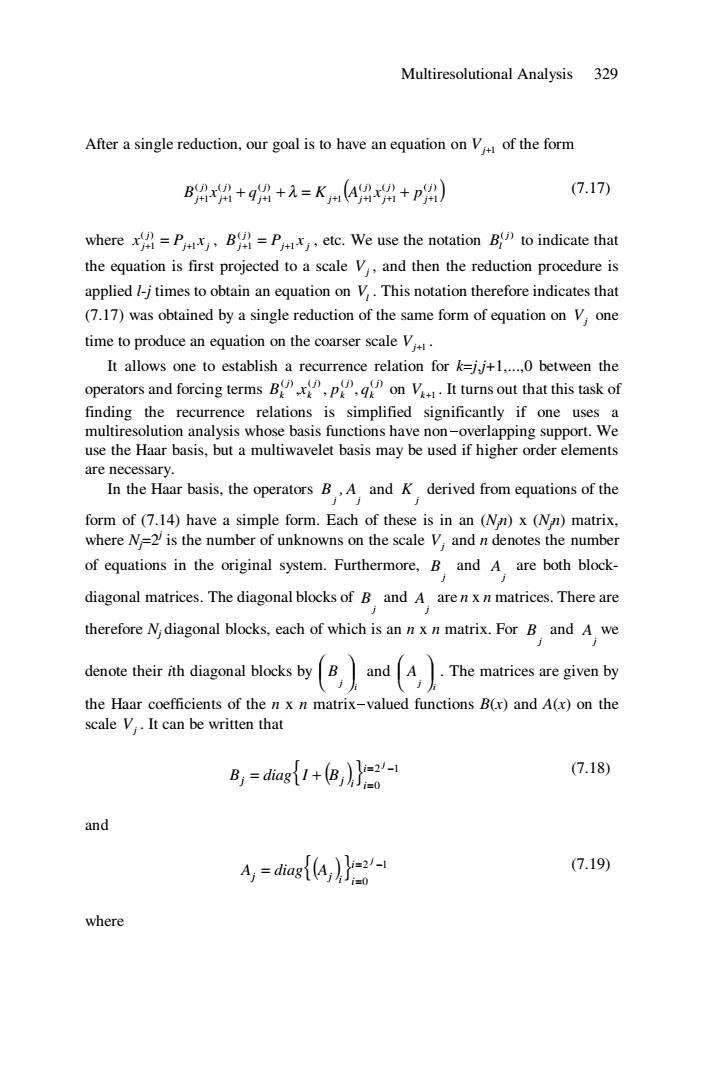正在加载图片...

Multiresolutional Analysis 329 After a single reduction,our goal is to have an equation on V of the form B阳x州+9州+元=K49州+P阳) (7.17) where=P B=P etc.We use the notation B(to indicate that the equation is first projected to a scale V,,and then the reduction procedure is applied /-j times to obtain an equation on V.This notation therefore indicates that (7.17)was obtained by a single reduction of the same form of equation on V;one time to produce an equation on the coarser scale V. It allows one to establish a recurrence relation for k=jj+1,...,0 between the operators and forcing terms Bpon V.It turns out that this task of finding the recurrence relations is simplified significantly if one uses a multiresolution analysis whose basis functions have non-overlapping support.We use the Haar basis,but a multiwavelet basis may be used if higher order elements are necessary. In the Haar basis,the operators B,A and K derived from equations of the form of(7.14)have a simple form.Each of these is in an (Nn)x(Nn)matrix, where N=2 is the number of unknowns on the scale V,and n denotes the number of equations in the original system.Furthermore,B and A are both block- diagonal matrices.The diagonal blocks of B and A are n x n matrices.There are therefore N,diagonal blocks,each of which is an n x n matrix.For B and A we denote their ith diagonal blocks by (e,】na(a The matrices are given by the Haar coefficients of the n x n matrix-valued functions B(x)and A(x)on the scale V,.It can be written that B,=dag{1+B,'-1 (7.18) and 4,=daga,)- (7.19) whereMultiresolutional Analysis 329 After a single reduction, our goal is to have an equation on Vj+1 of the form ( ) ( ) 1 ( ) 1 ( ) 1 1 ( ) 1 ( ) 1 ( ) 1 j j j j j j j j j j j j j B + x + + q + + λ = K + A + x + + p + (7.17) where j j j j x P x1 ( ) +1 = + , j j j j B P x1 ( ) +1 = + , etc. We use the notation ( j) Bl to indicate that the equation is first projected to a scale Vj , and then the reduction procedure is applied l-j times to obtain an equation on Vl . This notation therefore indicates that (7.17) was obtained by a single reduction of the same form of equation on Vj one time to produce an equation on the coarser scale Vj+1 . It allows one to establish a recurrence relation for k=j,j+1,...,0 between the operators and forcing terms ( ) ( ) ( ) ( ) , , , j k j k j k j k B x p q on Vk+1 . It turns out that this task of finding the recurrence relations is simplified significantly if one uses a multiresolution analysis whose basis functions have non-overlapping support. We use the Haar basis, but a multiwavelet basis may be used if higher order elements are necessary. In the Haar basis, the operators j j B , A and j K derived from equations of the form of (7.14) have a simple form. Each of these is in an (Njn) x (Njn) matrix, where Nj=2j is the number of unknowns on the scale Vj and n denotes the number of equations in the original system. Furthermore, j B and j A are both blockdiagonal matrices. The diagonal blocks of j B and j A are n x n matrices. There are therefore Nj diagonal blocks, each of which is an n x n matrix. For j B and j A we denote their ith diagonal blocks by i j B ⎟ ⎠ ⎞ ⎜ ⎝ ⎛ and i j A ⎟ ⎠ ⎞ ⎜ ⎝ ⎛ . The matrices are given by the Haar coefficients of the n x n matrix-valued functions B(x) and A(x) on the scale Vj . It can be written that { } ( ) 2 1 0 = − = = + j i i i j Bj B diag I (7.18) and { } ( ) 2 1 0 = − = = j i i i j Aj A diag (7.19) where